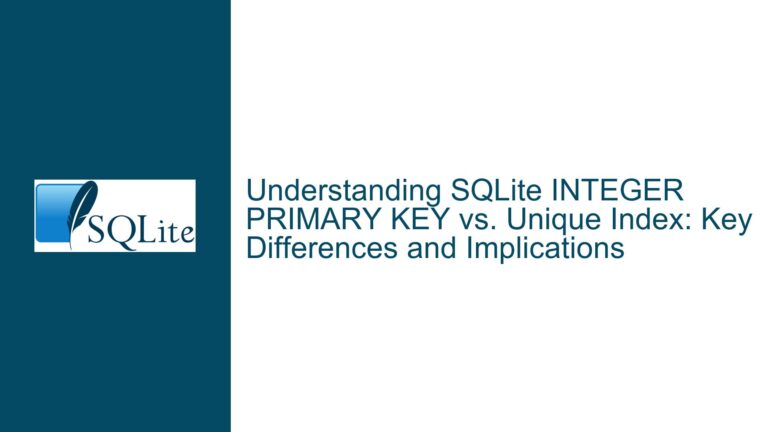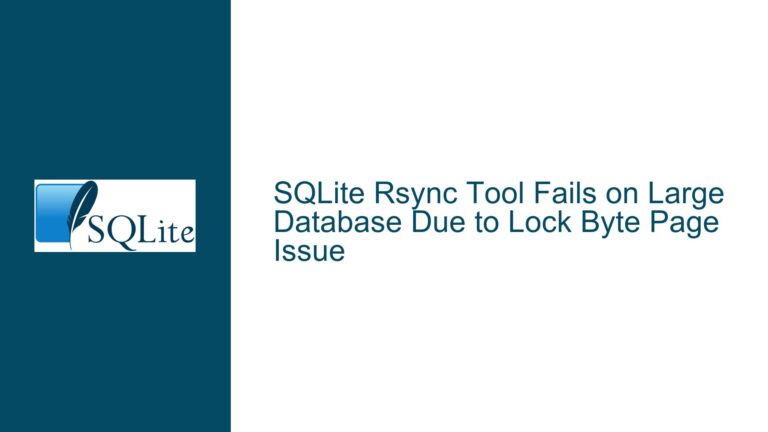Optimizing SQLite Storage for Large Arrays of Double Values in High-Performance Applications
Storing and Managing Large Arrays of Double Values in SQLite
When dealing with high-performance applications that require the storage and management of large arrays of double values, SQLite presents a unique set of challenges and opportunities. The core issue revolves around how to efficiently store and retrieve arrays of approximately 600 double values per record, with the total number of records potentially reaching up to 200,000. The current approach involves storing these values as a string, which, while space-efficient for small values, incurs significant overhead in terms of parsing and reconstruction whenever the data is modified or accessed.
The primary concern is the trade-off between storage size, performance, and maintainability. The current string-based approach, while compact, is not optimal for performance, especially in scenarios where the application must maintain data integrity in the event of crashes or power losses. The need to parse and reconstruct the string for every modification introduces unnecessary computational overhead. Additionally, the storage format must be robust enough to handle the high-frequency updates typical in high-performance environments.
Potential Causes of Inefficiency in Current Storage Methods
The inefficiency in the current storage method stems from several factors. First, the use of a string to store double values, while space-efficient for small values, requires parsing and reconstruction every time the data is accessed or modified. This introduces significant computational overhead, especially in high-performance applications where data integrity and speed are critical. Second, the string-based approach does not leverage SQLite’s native optimization capabilities for numeric data types, leading to suboptimal performance.
Another potential cause of inefficiency is the lack of a structured approach to storing the array of double values. The current method treats the entire array as a single entity, which makes it difficult to update individual values without reconstructing the entire string. This not only increases the computational load but also complicates the process of maintaining data integrity, especially in scenarios where the application must recover from crashes or power losses.
Implementing Efficient Storage Solutions for Large Arrays of Double Values
To address these issues, several storage solutions can be considered, each with its own set of trade-offs. The goal is to find a balance between storage size, performance, and maintainability.
Using BLOB for Storing Double Arrays
One approach is to use a BLOB (Binary Large Object) to store the array of double values. This method involves storing the array as a binary sequence, which eliminates the need for parsing and reconstruction. The BLOB approach is straightforward and leverages SQLite’s native support for binary data. However, the downside is that the storage size can become quite large, as each double value occupies 8 bytes. For an array of 600 double values, this results in a storage size of 4.8 KB per record. When multiplied by the total number of records (up to 200,000), the storage requirements can become significant.
Despite the storage size, the BLOB approach offers several advantages. First, it eliminates the need for parsing and reconstruction, which can significantly improve performance, especially in high-frequency update scenarios. Second, it simplifies the process of updating individual values within the array, as the entire array does not need to be reconstructed. This can be particularly beneficial in maintaining data integrity during crashes or power losses.
Creating a Dedicated Table with One Column per Double Value
Another approach is to create a dedicated table with one column for each double value. This method involves creating a table with approximately 600 columns, each storing a single double value. The advantage of this approach is that it leverages SQLite’s optimization capabilities for numeric data types, potentially leading to better performance and storage efficiency.
However, this approach also has several drawbacks. First, creating a table with 600 columns can be cumbersome and may lead to maintenance challenges. Second, the storage size can still be significant, as each double value occupies 8 bytes. Additionally, this approach may not be as flexible as the BLOB method, especially if the number of double values per record varies.
Vertical Storage with a Separate Table for Each Value
A more flexible and potentially more efficient approach is to store each double value in a separate table, using a vertical storage model. This method involves creating a table with columns for the record ID, the value index, and the double value itself. The primary key for this table would be a composite key consisting of the record ID and the value index.
This approach offers several advantages. First, it allows for efficient storage and retrieval of individual values, as each value is stored in a separate row. This eliminates the need to parse and reconstruct the entire array, leading to better performance. Second, it provides greater flexibility, as the number of double values per record can vary without affecting the overall structure of the database. Third, it leverages SQLite’s optimization capabilities for numeric data types, potentially leading to better storage efficiency.
The vertical storage model also simplifies the process of updating individual values, as each value is stored in a separate row. This can be particularly beneficial in maintaining data integrity during crashes or power losses, as only the affected rows need to be updated.
Comparing Storage Methods
To better understand the trade-offs between these storage methods, let’s compare them in terms of storage size, performance, and maintainability.
| Storage Method | Storage Size per Record | Performance | Maintainability |
|---|---|---|---|
| String | Variable (1-2 bytes per value) | Low (due to parsing/reconstruction) | Low (cumbersome to update individual values) |
| BLOB | 4.8 KB | High (no parsing/reconstruction) | Medium (straightforward but large storage size) |
| Dedicated Table (600 columns) | 4.8 KB | Medium (SQLite optimizations) | Low (cumbersome to maintain) |
| Vertical Storage | Variable (depends on number of values) | High (efficient retrieval/updates) | High (flexible and easy to maintain) |
Implementing the Vertical Storage Model
Given the advantages of the vertical storage model, let’s delve deeper into how to implement it in SQLite. The first step is to create the necessary tables. The main table, which we’ll call Records, will store the metadata for each record, such as the record ID and any other relevant information. The second table, which we’ll call RecordValues, will store the individual double values.
CREATE TABLE Records (
record_id INTEGER PRIMARY KEY,
-- other metadata columns
);
CREATE TABLE RecordValues (
record_id INTEGER,
value_index INTEGER,
value REAL,
PRIMARY KEY (record_id, value_index),
FOREIGN KEY (record_id) REFERENCES Records(record_id)
);
In this schema, the RecordValues table stores each double value in a separate row, with the record_id and value_index forming a composite primary key. This allows for efficient retrieval and updating of individual values.
To insert a new record with an array of double values, you would first insert the metadata into the Records table, and then insert each double value into the RecordValues table.
-- Insert metadata into Records table
INSERT INTO Records (record_id) VALUES (1);
-- Insert double values into RecordValues table
INSERT INTO RecordValues (record_id, value_index, value) VALUES (1, 0, 0.234);
INSERT INTO RecordValues (record_id, value_index, value) VALUES (1, 1, 0.8745);
INSERT INTO RecordValues (record_id, value_index, value) VALUES (1, 2, 23.646);
-- and so on...
To retrieve the array of double values for a specific record, you can use a simple SELECT statement.
SELECT value FROM RecordValues WHERE record_id = 1 ORDER BY value_index;
This query will return the array of double values in the correct order, allowing you to reconstruct the array in your application.
Optimizing Performance and Storage
While the vertical storage model offers several advantages, there are still ways to optimize performance and storage further. One approach is to use SQLite’s WITHOUT ROWID feature, which can improve performance for tables with a composite primary key.
CREATE TABLE RecordValues (
record_id INTEGER,
value_index INTEGER,
value REAL,
PRIMARY KEY (record_id, value_index)
) WITHOUT ROWID;
The WITHOUT ROWID feature eliminates the need for a separate rowid column, which can reduce storage size and improve performance for tables with a composite primary key.
Another optimization is to use SQLite’s PRAGMA commands to fine-tune the database’s performance. For example, you can use PRAGMA journal_mode = WAL to enable Write-Ahead Logging, which can improve performance in high-concurrency scenarios.
PRAGMA journal_mode = WAL;
Additionally, you can use PRAGMA synchronous = NORMAL to reduce the number of disk writes, which can improve performance at the cost of a slight increase in the risk of data loss in the event of a crash.
PRAGMA synchronous = NORMAL;
Conclusion
In conclusion, the vertical storage model offers a flexible and efficient solution for storing and managing large arrays of double values in SQLite. By storing each value in a separate row, you can achieve better performance, maintainability, and storage efficiency compared to other methods. Additionally, by leveraging SQLite’s optimization features, such as WITHOUT ROWID and PRAGMA commands, you can further enhance the performance and reliability of your database.
While the BLOB and dedicated table approaches have their merits, the vertical storage model provides a more balanced solution that addresses the core issues of storage size, performance, and maintainability. By implementing this model, you can ensure that your high-performance application can efficiently store and retrieve large arrays of double values, even in the face of crashes or power losses.






